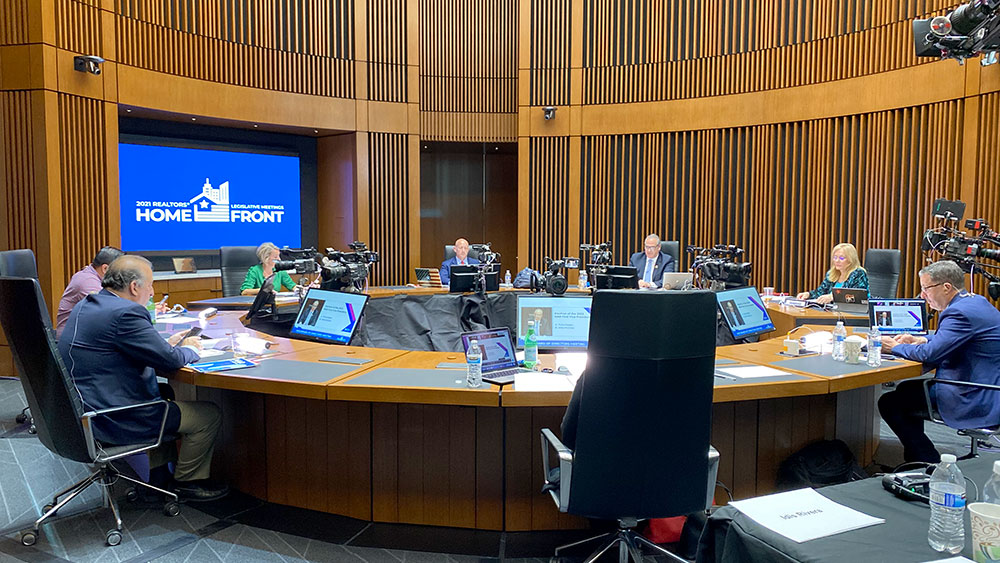
For the first fully hybrid National Association of REALTORS® Board of Directors meeting on May 14, the leadership met together in Chicago, while around 800 directors were remote. (Photos courtesy NAR)
At some associations, board meetings are the least-stressful events to plan, with far fewer logistics for business events organizers to wrangle than conventions, conferences, and trade shows. But the National Association of REALTORS® (NAR) isn’t one of those associations. More than 800 real estate industry professionals on the board of directors oversee the development and modification of policy, including constitutional amendments, as well as the administration of the funds of the association for more than one million members.
And that means that a lot of voting takes place — complicated enough to handle at an in-person meeting and challenging for an online meeting. But a mix of the two — with the first fully hybrid NAR BOD meeting on May 14 — required nothing short of a “huge team effort,” according to Idis Rivera, NAR’s director of governance programs.
In the end, “everything worked,” said Joe Faulder, director of creative and strategy at Projection, NAR’s audiovisual provider, “and I don’t think even the participants understood how much went on into engineering the solution.”
Perhaps the participants weren’t aware of what went into the planning and execution of this hybrid event but Convene wanted to hear all the details. We spoke via Zoom to Rivera and her colleagues, Jennifer Braun, senior events producer, and Alicia Bailey, head of production, as well as Faulder, for a behind-the-scenes look. Here are highlights of our conversation.
How and Why the Event Was Hybrid
Faulder: Ten members of the leadership team were together physically in the boardroom in Chicago and they were very specific about doing this because they wanted to create a sense of hope that we would all be back together again in person soon. I think that was really CEO Bob Goldberg’s initiative, and he pushed us, kind of kicking and screaming, into doing this because we had already figured out how to do it virtually and we were like, “Let’s just keep doing that because it’s great” — well, not great, but it works.
So we went into this knowing that we needed to accomplish managing 10 people locally, all of whom also needed to be able to vote on any business, and around 800 directors who are all going to be remote, all of whom needed to vote — and also be able to talk if they needed to.
And then the third group of stakeholders were the eight remote presenters who were going to give reports on particular pieces of business and they also needed to be able to vote securely. And all of that just needed to happen in one very seamlessly produced package where there was no friction.
Braun: The event itself took about two hours. At our Chicago headquarters, we had added on a conference level to our building. And that was the very first event that was held in that room. The leadership team hadn’t even seen it — almost nobody had seen it. And so we were dealing with new systems that were in the room, like AV, so that was another piece that we had to [figure out]— what do we use that’s already there versus what do we bring in? So that added yet another element to what we had to plan for.
COVID Considerations
Rivera: And also there were COVID guidelines that we had to adhere to, not just with Chicago, and Illinois, but also our property-management company and the guidelines we had to follow when we were in the building.
Braun: Out of the 10-person leadership team that would typically be at the head table, we had to create social distancing. So the key leadership team were at our built-in conference table, and we had to have a couple of parliamentarian and general council [members] at separate tables so we could meet the social-distancing requirements. Masks were required if you couldn’t keep up the six feet of social distancing. We were able to create the six-foot social distancing around the conference table so they did not have to wear masks while they were on screen but everybody else had masks on.
Anyone who was entering the building each day had to take a wellness quiz and have their temperature taken. And then we had cleaning of surfaces scheduled during breaks. Additional ventilation had been added to our building as a whole since the pandemic started.
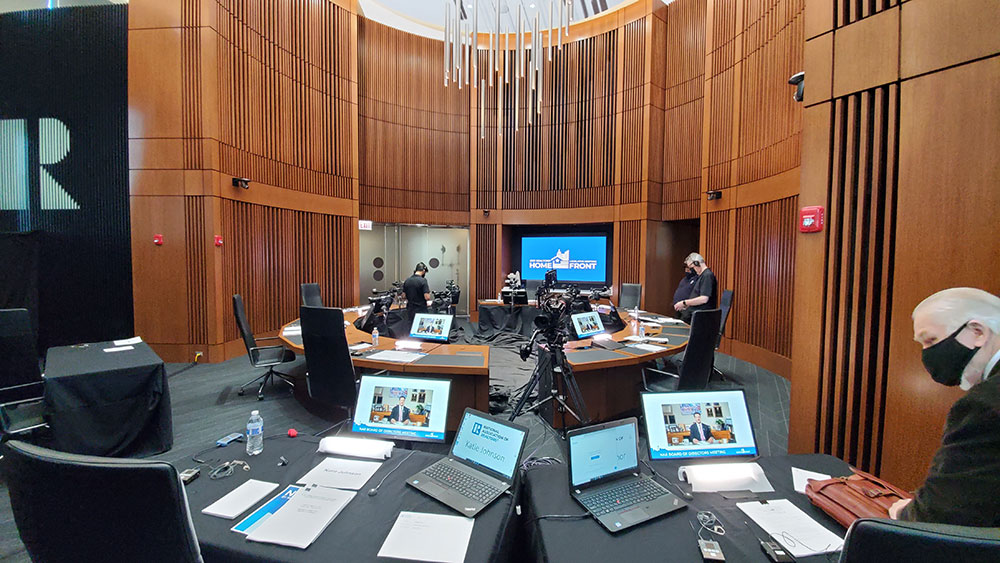
In the meeting space, the parliamentarian and another council member were seated at separate tables in order to meet the social-distancing requirements.
Highly Produced
Faulder: Since we were getting together and we were actually going to have our production team in the same space as the main talent, we decided to take the opportunity to make this much more produced than any of the previous virtual board of directors meetings, which were done within the parameters of Zoom, and with screen share, really using every bell and whistle that Zoom provides. But that was really the extent previously. We weren’t able to really title anybody or put anybody on a background or use any of the NAR branding that we normally use on any education or governance piece of program in any of the meetings.
We had to redesign a solution — the idea was anybody that was presenting or going to be on screen we were taking out of Zoom. If one of the participants wanted to raise their hand, there was a whole process for that. They’d raise their hand. They’d get recognized by the president who was presiding over the meeting. We would make them live.
What we were actually doing is we were taking them out of Zoom as a separate input into a video switcher and then putting them back into Zoom. But on a really nice background and a branded template so we could 100-percent control that 16:9 space. That took a bajillion computers. For every Zoom call, there were like six computers that could be sources back into our video mixer and an incredible amount of audio mixing, making sure there were no returns or delays. It was like a Zoom extravaganza but using a lot of traditional AV equipment in our control room for the backend engineering.
It really was a puzzle that we had to put together, knowing the tools we had to work with and how can we make all of this work while still giving people a seamless experience, whichever kind of stakeholder they were.
Alicia brought in MPG [Media Process Group], which is like a film crew — they do a lot of documentary and film work, and they work with NAR on a lot of their internal videos. Projection works on all the live events. So we came together on this particular event and partnered. Projection took care of all the backend engineering and MPG provided all of the cameras and the lighting in the main room. Everybody thinks the boardroom is super easy to work in — beautiful space, big windows, but as Alicia can attest, with the sun moving throughout the day, it made it almost impossible to control the lighting, which is really important for quality video.
MPG did a wonderful job of managing that, blacking out all the windows and putting very specialized dispersion LED lights in front of the presenters.
Everybody had a 24-inch monitor on a custom stand in front of them with a camera poking over the top — not a webcam, but a really nice, actual production-style camera. And so when they’re looking at their screen, it’s like they’re looking into the lens of the camera. We had control over their screens. And this was really interesting. We talked back and forth about this a lot because in a live event, the cardinal rule is you never show a presenter themselves in a return monitor like in a confidence monitor because they get distracted.
But we’ve been doing a year-and-a-half of Zoom, and we wanted to make the experience as similar to Zoom as possible for all the presenters. So they saw themselves, they saw the other presenters, anybody who was talking in two, three, four boxes — it was similar to what they’ve experienced all year and we rebuilt that in front of them.
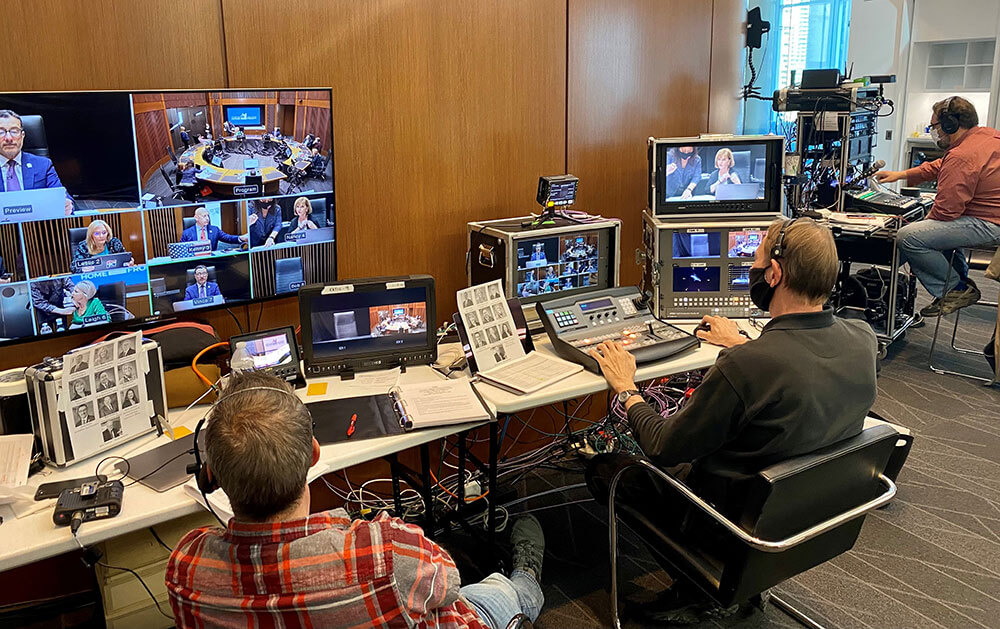
The video control room was set up in the back of the same board room where the NAR leadership met in person.
Using Zoom’s Capabilities
Faulder: Zoom has the raise-hand feature. So everything was delivered in a Zoom webinar. That was the end product for all of the 800-plus directors. So it’s real time, so that means in a webinar. It’s very hard to vote in a livestream because it’s usually delayed 15 to 40 seconds. So we had to deliver it in a Zoom webinar, as you can set up the backend admin permissions to enable the raise-hand feature, and NAR has a wonderful system, and they include a lot of their staff, actually, and Idis manages this process.
There were no questions or chat [features enabled], just raised hands. If you allow the chat in a meeting where they’re talking about parliamentary procedures, everybody’s going to be saying, “I’d like to change this word to that, or I want to do that in this resolution.” And you want to make it very simple — there’s only one way that the voting directors can communicate, which is raise your hand and talk.
We probably had about 20 staff on the backend of the Zoom webinar. One person’s job was just to lower hands when they were called to lower hands. Another person’s job was to promote people to panelist when they needed to speak. There was a very choreographed system. Usually at a particular point, Charlie Oppler, NAR’s 2021 president, would say, “Okay. Now, do we have any questions or objections from the audience?” And he would have a separate computer next to him with a list of participants and he would see hands going up. And in Zoom, the first person to put their hand up, goes to the top of the list. So he could call by name, and he’d call in two or three.
So the NAR team could promote all three of them quickly and we could be ready to switch them into the program feed. And that was practiced a lot.
Rehearsal Requirements
Faulder: I think a best practice to take away is the amount of practice and rehearsal that goes into this. NAR does two pre-BOD meetings — one, a week before, and one, a couple of days before. And this is for all of the 800 directors simply to come and test the technology. We do test votes. We make sure they’re comfortable with the environment. And each one is presided over by Charlie, who’s running the main one.
Those meetings are all about [talking] them through [the platform]. And then on top of that, we did a full dress rehearsal, which we don’t usually do for the board of directors. We went through almost three quarters of the program the day before the show, just so everybody could get used to the flow and what they were looking for.
Rivera: This was definitely a huge team effort. I oversee the content of the meeting, which is very scripted and in rehearsals, we go through a lot of pro tips with our directors to make sure that they are set up with their technology. If you’re using a laptop to view the meeting or you’re using a mobile device to submit the voting, that’s what we go through in our pre-meetings so that they’re well-prepared for the actual meeting. But then the backend has staff who were supporting these meetings.
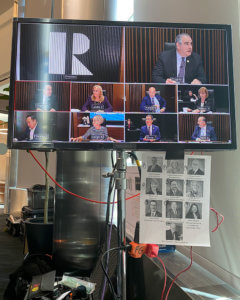
A cheat sheet hanging from the audio multiview screen identifies the NAR leadership team members on screen.
We tried to simulate an in-person meeting as much as possible. And in person, only directors can speak to a motion through mics that are situated in the aisles of a meeting room. So we promoted a director to a panelist so that they can be recognized and then they could speak — that was our solution to only directors speaking. And only directors were on the webinar. We livestreamed the board of directors, so any registered participant could view the board meeting through another meeting platform.
Thinking Through Every Possible Scenario
Rivera: We had countless, countless meetings to go through our logistical outline — every single logistic that is needed for the meeting, whether it was Zoom settings, who was going to do what, identifying which staff was responsible for what role, and contingency plans. Like: What happens if the voting platform goes down, then what do we do? Our contingency plan was to use the Zoom polling. And then, okay, who was going to be in charge of that? It’s just not working with our sync-up voting platform, which is what we use, but also making sure that some polling was ready to go if we needed to transition to that, and then have that scripted for our president. It’s a very well-orchestrated meeting.
It took a lot of staff hours and a lot of staff time before entering the meeting to make sure that it was seamless and it was the best experience possible for our directors. And the feedback we’ve gotten back has been very, very positive.
Braun: One other thing too, talking about backup systems, we had to be prepared too if internet went out or power went out — what are we going to do in each of those instances? And we had a backup plan for each one. If for some reason, production software went down, we had backup computers in different offices and conference rooms where we would take a break to get everybody out of the boardroom and into the private offices so that we go back via Zoom and resume the meeting.
And if something went down and we weren’t going to be able to get it up, at what point do we cancel the meeting and reschedule it and start from where we left off? We had to communicate that to a lot of stakeholders so that everybody knew how to communicate to the directors if something goes wrong, to explain what’s happening and give updates as we have them.
The amount of detail and the number of people that it took to pull this off was absolutely unbelievable. And the teamwork, I cannot stress that enough. The teams that were involved in this included two production companies, multiple teams within the association, the leadership team. It required everybody to come together and work together. And I don’t know that in all my years of doing this, that I’ve seen something on such a huge level come together and the people work together the way everybody did. It was truly remarkable.
We started in February or March. And the entire internal team met on a weekly basis and went through each specific piece. And then if we had to have other additional side meetings, then those would get scheduled to work through any kinks that we found. I think the process worked. It was very complicated but everybody really came together and it showed in the final product.
Putting the Pieces Together
Bailey: When I look back on this whole thing, I think we definitely went through several phases of this work. There was the phase of denial like, do we really have to do this? We’re in a pandemic, is this even possible?
So the first time we all met in the office we had that feeling of, “Wow, I haven’t even seen you in a year. And here we are in this space. We’re the first people to see this space completed.” And then to have to shift from just thinking about sharing physical space with each other to then the actual space and making it work. It was brand-new so there were elements of this space that were incomplete —equipment that had come in, but it was the wrong equipment or something like that, or things that needed to be repaired or replaced.
So having to think about those things. And then distancing everyone — who actually needs to be in this room, who doesn’t need to be in this room? Which production company is going to be responsible for what? We had to have that initial conversation. Roles and responsibilities were critical in the beginning phases.
And then once we established, okay, Projection does the backend, MPG does the front end. We also brought in an audio engineering company to help support the camera work and all of that kind of stuff. And then we went through the phase of bringing the wider NAR team in on this idea that we had and having to sell them on it. And keeping front of mind this is a meeting and business has to be conducted here.
So it’s like marrying the beauty of the production to the work that needs to happen and who needs to be there to play such a critical role. And how do we get all of these people in the room, at home, wherever you are to participate and make it seamless?
I think this is the key to hybrid experiences. There comes a point where you have to be willing to jump into the unknown and take the risk. Because if you only do what has worked in the past and what you’re comfortable with, you’re never really going to push the needle forward. I mean, it was pushing it very far forward.
We really had to trust one another and get comfortable with the idea that this could fail.
I don’t think there’s a better example of everyone really having one goal and bringing their expertise to the table to share in making that goal a reality. I think that is probably key there. I can’t think of a better example of that in my years at NAR where everyone just did what they needed to do for the betterment of this particular event and making sure that it was seamless. Being in production as many years… stuff happens and I was waiting for whatever it was to happen and it just didn’t. It was so smooth.
Braun: I still want to knock on wood as you’re saying that just to be safe.
Faulder: I think though, building up your point, Alicia, is that poking holes is such an important part in design. And I don’t think people really aware that we were designers in this process. We’re meeting designers in a hybrid experience. I think that you guys do a wonderful job of putting the right team of players together where you’ve got IT, you’ve got governance professionals, and everybody is there to hear the idea and then say, “Okay, and what if this, and what if that.” And the result is a little anxiety for all of us in production because we come to those calls and we’re like, “Somebody is going to find something we haven’t thought of.” Which is great though, because you’ve come out of it with a better solution.
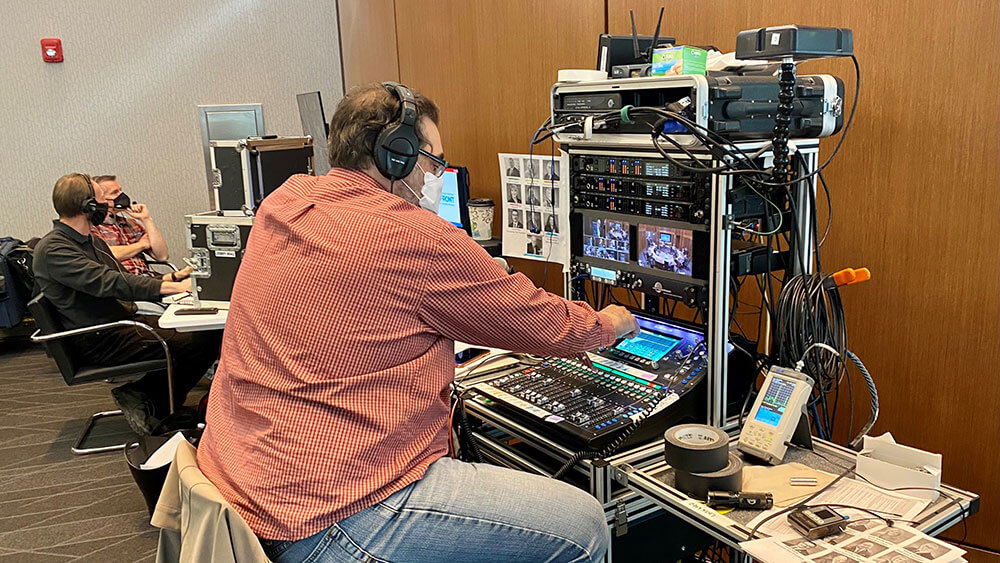
NAR BOD organizers used an audio engineering company to help support the video work.
An Imperfect Solution
Faulder: So there was one part that wasn’t, in terms of a design perspective, perfect. And that was how we were managing the remote presenters in the solution that we came up with. It was because we were asking a lot of them. If you were a remote presenter in this meeting, not a director, but somebody who had a piece of content to deliver from their home, we were asking them to have a computer to present in a Zoom meeting, which wasn’t even the webinar. It was a completely separate meeting just for them that we were taking as a source. They needed to be signed in on that computer with a Projection Zoom account.
They then needed a personal device to be able to vote like a phone. And so that was two devices. So that’s where your voting was happening. Then they needed a third device that was logged in, either a computer or a tablet to the actual Zoom webinar only if we had to move to backup polling. We needed to be able to give them the backup solution that everybody else had. So it was eight people that we had to really work hard with. And we had a whole hour-and-a-half call with just them to make sure they were all set up perfectly.
And the second device signing them into a separate Zoom account is because depending on your Zoom provider, if you have a personal account or a business account, not all Zoom accounts let you sign into two meetings at the same time. That has to be set in the background. That’s why we had to talk them through using a Projection account for one of the meetings and their own account for the other, just in case.
That point stalled us for a little bit in planning because we thought, “There must be a better way to make it easier for them.” At the end of the day, we said, “We just have to roll with this.” There always comes a point, I think, where you have to just say, “Let’s go with this because we can’t keep turning our wheels.”
The Power of Trust
Rivera: I want to add to Alicia’s comments about trusting each other as a team. Not just the ask from the leadership team, but the trust that they put on the staff team to make this happen and the support on the decisions that were made, like Joe just mentioned with how to handle the presenters. At a certain point, you just have to trust that Joe knows what he’s talking about, because he is the expert and that he will make it happen. So I think that’s important also just to acknowledge that we had the support of the leadership team, of the senior management team on the decisions that were being made to make sure that we reached the goal that they’d set in front of us.
And the willingness of the members to take direction from us also I think is important — to know that they also trusted that we knew what we were doing and what we were asking them to do.
Bailey: I always think about production like a well-oiled machine when the talent, if you will, can come in and just do their thing and not really have to worry about it. There was no level of stress for them, even though this was a completely foreign experience for everyone on the front end and the backend. The leadership team came in and they were able to enjoy the experience. I think that that’s part of what made it successful is they felt comfortable enough. And that was part of the teamwork where that was intentional — everything was pretty much set out for them where all they needed to do was their part.
We ran through the rehearsals with them. And they just enjoyed the meeting and enjoyed being in that space with one another again.
The feedback that we got from people at home — [all of our efforts] made a big difference for them. They saw it and they’re like, “Wow, the production on this, it’s beautiful.” They felt like they were in the space too just the way that it was produced, seeing the sweeping shots and things of that nature and those cutaways and everything that they were experiencing made it feel more engaging to everyone. And no matter where you were, you felt like you were a part of the experience.
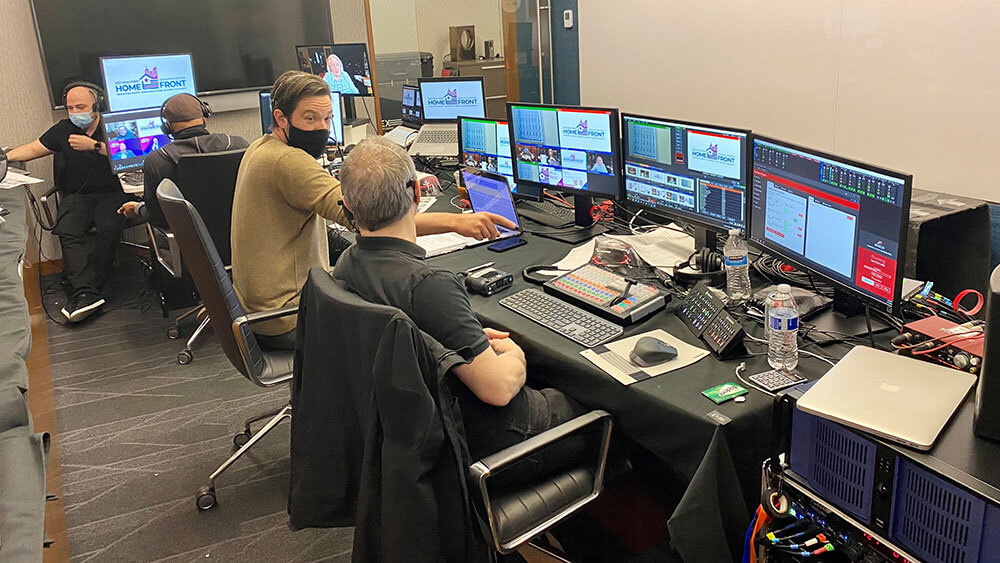
The “unbelievable” number of people it took to produce the BOD meeting included two production companies, multiple teams within the NAR, and its leadership team.
What’s next
Bailey: We will not be doing a hybrid version [going forward]. Famous last words. Right now the board of directors meeting is going to be in person only as we return to live events. We are doing other sessions in a hybrid format. But the board of directors will only be an in-person event moving forward, as well as all of our other governance meetings that take place prior to that. So the plan for us right now is to keep with board of directors live. But never say never.
NAR does see the value in the hybrid experience. And I think this is the beauty of it. Figuring out those things that are best served in person and can be done in person, and those things that our members who may not be able to make it, how do we keep them engaged and a part of the process? We are making investments in the hybrid experience going forward — identifying which events, which meetings will fall into that space.
Faulder: We had our first design conversation for the annual meeting that’s happening in November. And we were talking about how much do we need to design for the virtual audience. And one of the things we brought up was the use of the jib — the big sweeping camera arm that you get at the beginning of new shows or any TV production — in the boardroom. That’s not something typically that you would see on an association virtual event. However, it really brings that virtual audience into the space. And you go, “Ooh, what is this? This is nice.”
If you’re putting a really beautiful room together in a convention center, and you want to make your virtual audience feel like they’re there, having two or three really tasteful shots with a jib that lets them see either what they’re missing, so come next year, or that you’re part of this too and this is all part of the experience, is something that is being talked about now. And also in the past, it used to be like, give them the slides and the face on stage and you’re good.
Bailey: There’s no going back now.
Braun: As any planner knows, the attention to detail is key. If you overlook one detail or you brush off something, that’s where your problem is going to be. You have to take the time and make sure that all of the details are worked out because if you don’t, then that’s going to be the one area where you go, “I knew it.” All of the core meeting planning strengths came into play with this, but they are times 10 for just this one event. You have to start with the basics and plan from there.
Something I’m seeing a lot of event tech professionals talk about is that the more production you add to a meeting, the less personal and engaging it is for the presenters and the audience. Because you put all these layers in between the audience. I am somebody who doesn’t believe it has to be that way, if you design the technology appropriately — like we’re talking about having somebody in another Zoom bringing that other Zoom back into their Zoom so they can see the audience.
There’s a way that you can have production and engagement at the same time. The board of directors meeting where there has to be ultimate participation is a great example of that in terms of ultimate production and ultimate participation, and I’m just looking forward to carrying that on in the hybrid world.
Michelle Russell is editor in chief of Convene.
